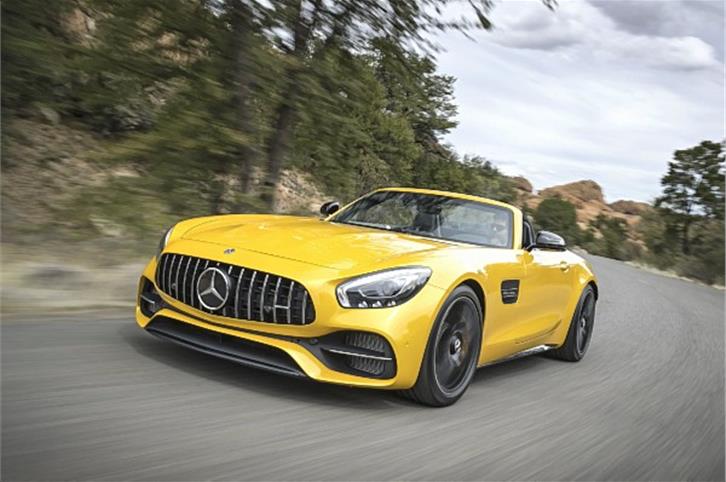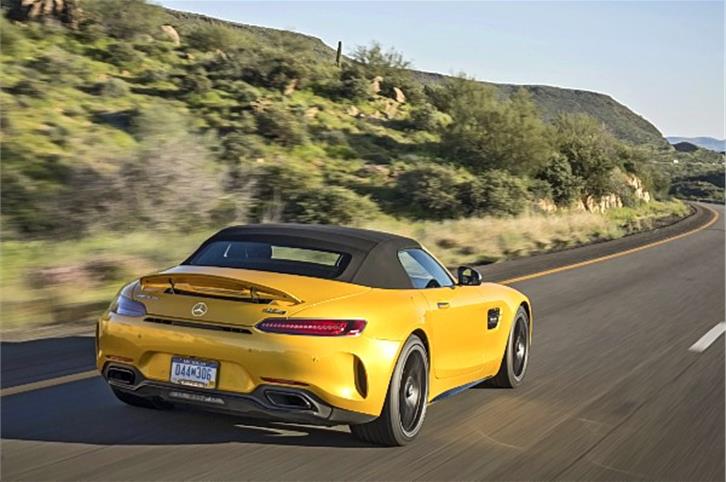2017 Mercedes-AMG GT C Roadster review, test drive
All that’s good about the AMG GT with the option to lower the roof. What’s not to like?
Published on Mar 31, 2017 10:13:00 PM
17,877 Views
Follow us on



What’s it like to drive?
First, a bit about the roof. The three-layer fabric roof absorbs noise quite well. It’s never absolutely hushed in the cabin but you won’t have to raise your voice to converse with your co-passenger at least at average town speeds. Lowering the roof, though, does increase noise levels more than expected. There is a wind deflector on the rear sill but there’s still plenty of buffeting in the cabin even at cruising pace. Press down on the throttle with gusto, though, and it’s the engine that you’ll hear loud and clear. The note from the V8 is throaty with pops and crackles on the overrun.
And of course, this is a fast car. The GT C is ferociously quick to build speed and launch you onto the wrong side of the speed limit without even trying too hard. Its twin turbos seemed armed and ready at all times; there’s no lag and delivery is consistently strong all through the rev range. You just don’t experience that typical turbo car pause between commands at the throttle being executed at the rear wheels. Sure, this is the more powerful GT C but I don’t think the India-bound GT would be much slower. Mercedes-AMG claims a 0-100kph time of 3.7sec for the GT C Roadster and 4.0sec for the GT Roadster. Do note the GT Roadsters, with kerb weights above 1.6 tonnes, are no lightweights. Coupe to Roadster, the GT has gained 50kg thanks to the fabric roof and additional bracing to compensate for the loss of rigidity on account of the roof. The GT Roadster's aluminium body is stiffened with thicker sill elements, an additional dashboard support and a new aluminium cross-member integrated into the rear bulkhead that supports fixed roll-over bars.
On the smooth roads around Phoenix, Arizona in the USA, we didn’t experience any of that scuttle shake that is characteristic of convertibles. What the GT will be like on the pockmarked roads outside Phoenix Mills, Mumbai is what we’ll have to see in the future. In general, the ride did feel a bit firm, though the GT C’s standard adjustable dampers did help take a bit of the edge away.
As mentioned, the GT C comes with rear-wheel steering. At speeds up to 100kph, the rear wheels turn in the opposite direction of the front wheels for added agility and at speeds above 100kph, the rear wheels turn in the same direction as the ones in front for enhanced stability. And the system does its work really well. On twisty canyon roads, the GT C felt smaller and tighter than we remember the GT S Coupe. There’s no getting around the sheer width of the GT but the rear-wheel steer helps place the car through corners with more clarity. There’s also tremendous grip out of the corners with the electronically controlled limited-slip differential feeding just the right amount of power to the wheels. The GT C’s steering is quick too and seemed more nuanced than the GT S Coupe’s rack that was a bit too sharp just off-centre.
Copyright (c) Autocar India. All rights reserved.






















Comments
Member Login
Personal Details
No comments yet. Be the first to comment.